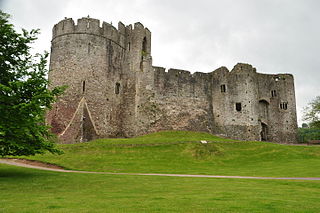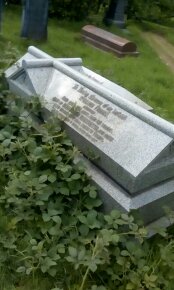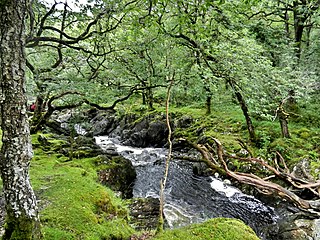Related Research Articles

Marquess of the County of Bute, shortened in general usage to Marquess of Bute, is a title in the Peerage of Great Britain. It was created in 1796 for John Stuart, 4th Earl of Bute.

Castell Coch is a 19th-century Gothic Revival castle built above the village of Tongwynlais in South Wales. The first castle on the site was built by the Normans after 1081 to protect the newly conquered town of Cardiff and control the route along the Taff Gorge. Abandoned shortly afterwards, the castle's earth motte was reused by Gilbert de Clare as the basis for a new stone fortification, which he built between 1267 and 1277 to control his freshly annexed Welsh lands. This castle may have been destroyed in the native Welsh rebellion of 1314. In 1760, the castle ruins were acquired by John Stuart, 3rd Earl of Bute, as part of a marriage settlement that brought the family vast estates in South Wales.

Chepstow Castle at Chepstow, Monmouthshire, Wales is the oldest surviving post-Roman stone fortification in Britain. Located above cliffs on the River Wye, construction began in 1067 under the instruction of the Norman Lord William FitzOsbern. Originally known as Striguil, it was the southernmost of a chain of castles built in the Welsh Marches, and with its attached lordship took the name of the adjoining market town in about the 14th century.

William Burges was an English architect and designer. Among the greatest of the Victorian art-architects, he sought in his work to escape from both nineteenth-century industrialisation and the Neoclassical architectural style and re-establish the architectural and social values of a utopian medieval England. Burges stands within the tradition of the Gothic Revival, his works echoing those of the Pre-Raphaelites and heralding those of the Arts and Crafts movement.

Raglan (; is a village and community in Monmouthshire, south east Wales, United Kingdom. It is located some 9 miles south-west of Monmouth, midway between Monmouth and Abergavenny on the A40 road very near to the junction with the A449 road. The fame of the village derives from Raglan Castle, built for William ap Thomas and now maintained by Cadw. The community includes the villages of Llandenny and Pen-y-clawdd. Raglan itself has a population of 1,183.
Dame Joan Evans was a British historian of French and English mediaeval art, especially Early Modern and medieval jewellery. Her notable collection was bequeathed to the Victoria and Albert Museum in London.

Sir William Goscombe John was a prolific Welsh sculptor known for his many public memorials. As a sculptor, John developed a distinctive style of his own while respecting classical traditions and forms of sculpture. He gained national attention with statues of eminent Victorians in London and Cardiff and subsequently, after both the Second Boer War and World War I, created a large number of war memorials. These included the two large group works, The Response 1914 in Newcastle upon Tyne and the Port Sunlight War Memorial which are considered the finest sculptural ensembles on any British monument.

Park House, 20 Park Place, Cardiff, Wales, is a nineteenth century town house. It was built for John McConnochie, Chief Engineer to the Bute Docks, by the Gothic revivalist architect William Burges. It is a Grade I listed building. The architectural historian John Newman writes that the architectural style of the house "revolutionized Cardiff's domestic architecture," and Cadw considers the building "perhaps the most important 19th century house in Wales."

Llanfechain is a village and community in Powys, Wales, on the B4393 road between Llanfyllin and Llansantffraid-ym-Mechain. Historically it belonged to Montgomeryshire. The River Cain runs through. The population of 465 at the 2011 Census was estimated at 476 in 2019.

Architecture in Cardiff, the capital city of Wales, dates from Norman times to the present day. Its urban fabric is largely Victorian and later, reflecting Cardiff's rise to prosperity as a major coal port in the 19th century. No single building style is associated with Cardiff, but the city centre retains several 19th and early 20th century shopping arcades.

William Frame was an English architect.

There are around 1,000 listed buildings in Cardiff, the capital city of Wales. A listed building is one considered to be of special architectural, historical or cultural significance, which is protected from being demolished, extended or altered, unless special permission is granted by the relevant planning authorities. The Welsh Government makes decisions on individual cases, taking advice from the heritage agency Cadw, the Royal Commission on the Ancient and Historical Monuments of Wales and local councils.
Sir Alfred William Clapham, was a British scholar of Romanesque architecture. He was Secretary of the Royal Commission on Historical Monuments (England) and President of the Society of Antiquaries.
Alan Charles Nelson Borg is a British historian. He is a former director of the Victoria and Albert Museum and librarian of the Order of St John.
Thomas Alexander "Sandy" Heslop,, publishing as T. A. Heslop, is a British academic who specialises in the art and architecture of medieval England. He is Professor of Visual Arts at the University of East Anglia (UEA). He was Slade Professor of Fine Art at the University of Cambridge for the 1997/1998 academic year.
Francis P. Kelly is a British architectural historian and formerly an inspector for English Heritage and Historic England, working in the south west of England. He has contributed to a number of publications on medieval buildings, and his extensive slide collection is held by Historic England. He is a member of the British Archaeological Association.

Twmpath Castle, also known as Twmpath Motte, is a medieval motte on the southern slope of Wenallt Hill near Rhiwbina in Cardiff, Wales, which is a scheduled monument.
William Iveson Croome, CBE, FSA, MA (1891-1967) was an archaeologist. A man of strong faith, he devoted much of his time and expertise to the care and conservation of ecclesiastical buildings.

Dolmelynllyn Estate is an area of farmland, woodland and parkland near the village of Ganllwyd in southern Gwynedd, Wales. It is owned by the National Trust. The estate was formerly owned by William Madocks, the architect of Porthmadog. Features of the estate include ancient woodland, temperate rainforest, rare lichens and mosses, as well as archaeological features from prehistoric cists to nineteenth-century gold mines. The estate also has 46 bee boles on it, which is the highest concentration in the United Kingdom.
References
- 1 2 "Alexander David MCLEES - Personal Appointments (free information from Companies House)". find-and-update.company-information.service.gov.uk. Retrieved 1 March 2021.
- ↑ "The obituary notice of David McLees". funeral-notices.co.uk. Retrieved 1 March 2021.
- ↑ "Pupil Records 1946 to 1967". www.madrascollegearchive.org.uk. Retrieved 1 March 2021.
- ↑ "Rugby 1947 to 1967". www.madrascollegearchive.org.uk. Retrieved 1 March 2021.
- ↑ "Madras Trophies". www.madrascollegearchive.org.uk. Retrieved 1 March 2021.[ additional citation(s) needed ]
- ↑ McLees, A. D. (1969). Parish architecture in Gloucestershire (MA). London: Courtauld Institute of Art. – The thesis is on shelf at the Courtauld under the class mark A969.GLO MCL
- ↑ none (1 January 2000). "The British Archaeological Association Annual Report and Accounts". Journal of the British Archaeological Association. 153 (1): 182–198. doi:10.1179/jba.2000.153.1.182. ISSN 0068-1288. S2CID 218679795.
- ↑ "Proceedings of the Society of Antiquaries of Scotland. Volume 108". www.google.com. 1977. Retrieved 1 March 2021.
- ↑ McLees, David (1988). Castell Coch. Cadw. ISBN 1857600835.
- ↑ McLees, David (2005). Castell Coch. Cadw. ISBN 1857602102.
- ↑ McLees, David (2018). Castell Coch. Cadw.
- ↑ "Salon 110". Society of Antiquaries of London. 14 February 2020. Retrieved 1 March 2021.
- ↑ WalesOnline (22 February 2005). "Light shed on vineyard steeped in history". WalesOnline. Retrieved 1 March 2021.
- ↑ WalesOnline (26 January 2006). "'Please look after your terrace ... you just can't know how special it is'". WalesOnline. Retrieved 1 March 2021.